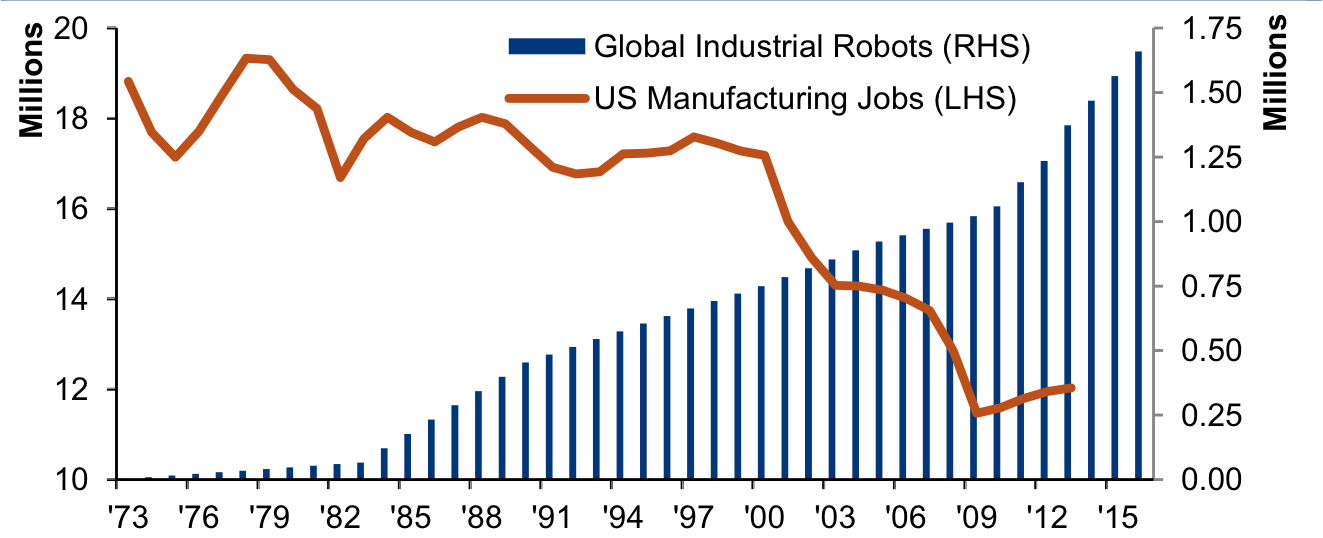From RoboHub:

A new 300-page research report from Bank of America Merrill Lynch, Robot Revolution – Global Robot & AI Primer, and to a lesser extent BSG’s report: Man and Machine in Industry 4.0, make for interesting reading and highlight the role of AI and the changing nature of jobs and work in the exponential growth of the robotics industry.
“We are facing a paradigm shift which will change the way we live and work,” the authors of the BoAML report said. “The pace of disruptive technological innovation has gone from linear to parabolic in recent years. Penetration of robots and artificial intelligence has hit every industry sector, and has become an integral part of our daily lives.”
FORECASTS:
The BoAML report projects that the total global market for robots and artificial intelligence will reach $152.7bn by 2020, and estimates that the adoption of these technologies could improve productivity by 30% in some industries.
This “revolution” could leave up to 35% of all workers in the UK, and 47% of those in the US, at risk of being displaced by technology over the next 20 years, according to an Oxford University study cited in the BoA ML report.
Robot & AI-related technologies, services, and solutions are core to the business projections in the BoAML report which also sees fast growth in the following areas:
- Warehouse logistics is likely to be a major growth area, where robots can be used to move merchandise from shelves to packing and shipping areas. Advances in pattern recognition and dexterity could eventually also allow warehouse robots to load and pack items for shipment.
- Mining activity is becoming increasingly automated along the entire supply chain, from robotic drilling to autonomous haulage and loading.
- Elder care services are also well-suited to increased robotics penetration given rising global dependency ratios and repetitive, round-the-clock demands. Such robots are already being used to lift elderly people in nursing homes and hospitals. They include exoskeletons that can be worn by seniors to help with movement or by individual caregivers to assist in lifting. In 2013, Japan initiated a program to pay two-thirds of the expenses associated with developing low-cost robots for elder care and specified the need to improve social welfare delivery in order to prevent workers from leaving the labor force to support elderly relatives at home.
- Telemedicine is another growing source of robotics demand, with the Food and Drug Administration clearing the first remote presence robot for use in hospitals in 2013. The robot can be controlled remotely or map Its own path on the hospital floor, allowing real-time communication between off-site physicians and on-site patients via a mounted video display, camera, microphone and speakers.
- In agriculture, automation is already being widely practiced in milking and increasingly in precision techniques that use sensors and drone-mounted cameras to monitor soil for temperature, moisture and nutrient content. A significant portion of fruit and vegetable harvesting is still performed manually, but new mechanical techniques are emerging on the back of improvements in robotic vision and dexterity.
MEDIA SPIN:
A personal pet peeve: hyper headlines about the reports:
- The Wall Street Journal: Merrill Lynch Warns of Robot Apocalypse
- MarketWatch: These are the stocks to watch as robots take over the world
- BloombergBusiness: Bank of America Picks 10 Key Stocks to Watch as Robots Take Over the World
- Business Insider: Almost half of all US workers are at risk of losing their jobs to robots
- Forbes: Killer cars and robotic teddy bears
- Daily Express (UK): Fears of killer robots increase as machine revolution now firmly underway
9 KEY STOCKS TO WATCH:
Among more than 200 companies Bank of America identified as set to benefit from the rise in robotics, health-care and industrial automation are currently the only industries with particularly high exposure. Here is their list:...MORE